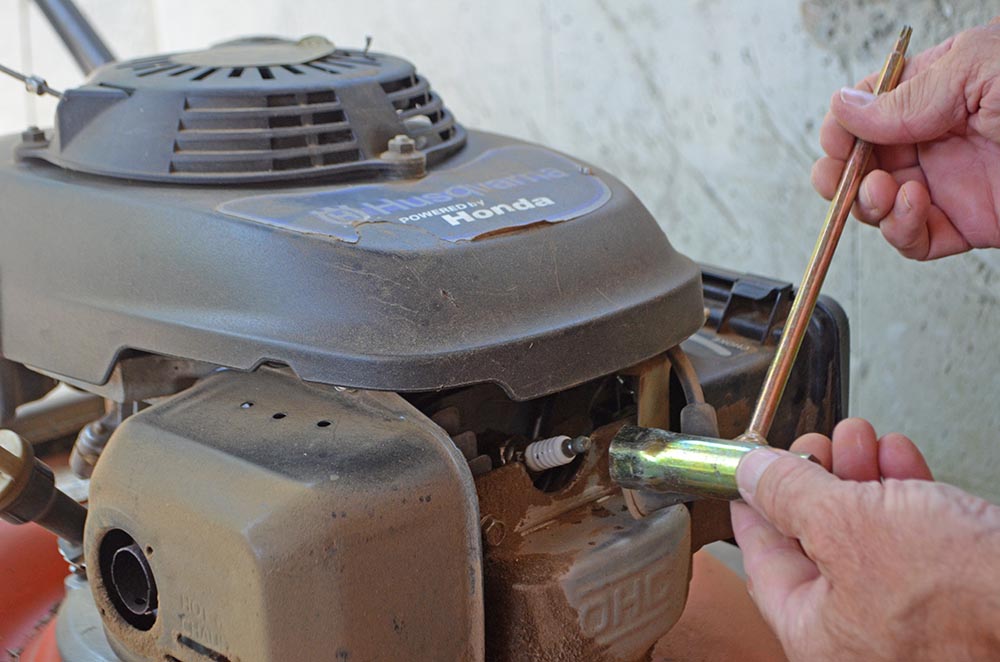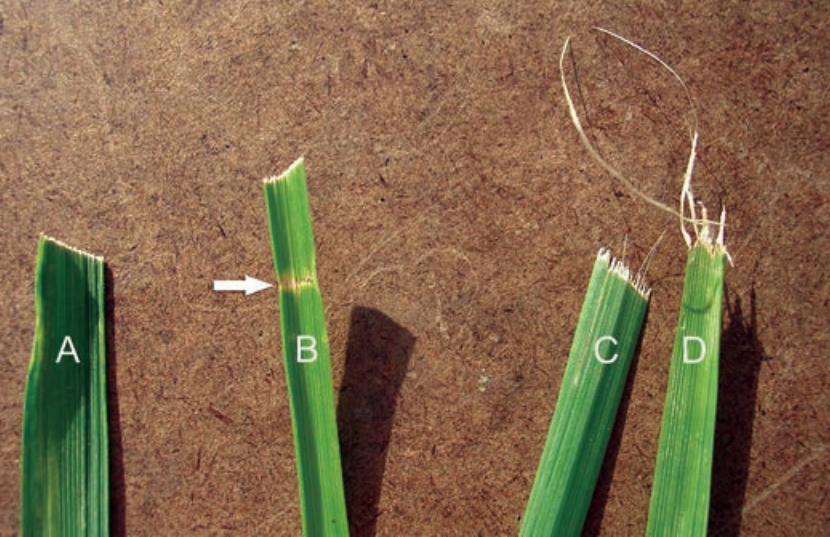
When the mowing season has ended and winter is approaching, it is time to put away your lawn mower. This article explains, step-by-step, how to winterize your lawn mower, so that you can avoid problems at start-up in the spring.
How to Winterize a Lawn Mower, Step-by-Step
The grass has stopped growing, but wait: Your work isn’t done yet. Lawn mower maintenance is critical before saying goodbye to the mowing season.
Step 1: Burn Off Any Fuel
Simply turn it on and let it run until it stops. It will prevent problems from developing over the winter, such as the fuel line clogging. In the spring, you are better off starting with a fresh load in the fuel tank.
Gasoline left in a lawn mower will degrade after a few months, becoming a gel that can clog in fuel lines. If you aren’t going to burn off the fuel or remove it, you can add fuel stabilizer, which is a liquid that you use to fill the tank. Run the engine for a few minutes after you get a full tank of stabilized fuel to pull the mix through the lines, then shut it off for the winter months.
Step 2: Change Your Spark Plug and Air Filter

Photo Credit: Derek Lacey
Spark plug: Some people just disconnect the one in place, but spark plugs should be replaced every year. Plus, for what a spark plug costs (less than $10), you should consider installing a new one.
If you don’t want to just replace it, you can check your spark plug with a spark plug test tool. While the plug is out, spray a small amount of light lubricating oil into the cylinder through the spark plug hole.
Then pull the starter cord a few times to work the oil into the cylinder of the mower engine. It’ll stave off rust and keep all those moving parts moving.
Air filter: While you have the spark plug out, check your air filter, too. Clean foam filters with water or replace paper ones that are dirty.
Step 3: Sharpen the Blade

Do it yourself, or take it to a shop that will do it. Sharpening the lawn mower blade will ensure that the lawn mower works efficiently next spring. Plus, you can purchase another lawn mower blade, to have it on hand in case you need it.
Step 4: Balance the Blade
It is easy to have a shop do this for you. It also can prevent the common DIY mistake of putting in the blade upside-down. It will work, but not as well as it should.
Step 5: Scrape the Undercarriage

You do this while the blade is off. Use a putty knife or a screwdriver. It removes chunks of grass and clippings. That buildup can hold water, leading to rust. People who have a pressure washer might use it.
Step 6: Hose Off the Outside
DIYers can use a garden hose (carefully, to avoid water getting in the motor), or you can wipe it down with a rag. But get off any mud, dirt, or bits of leaves.
Step 7: Change the Oil

Photo Credit: Derek Lacey
Also check the other fluids. The owner’s manual will give the proper levels. Doing an oil change will extend the life and the performance of the mower. It is better to winterize with new oil; old oil has impurities that can damage engine parts.
Step 8: Inspect the Belts
This is especially important for a riding mower. You want to make sure they are neither frayed nor out of adjustment.
Step 9: Inspect the Pull Cord
If it is fraying, you will want to have it replaced.
Step 10: Cover the Lawn Mower
Once it has cooled, you can use a garbage bag or a tarp.
Step 11: Check the Tires
It is a good time to be sure they are properly inflated.
Step 12: Store it for Winter
Toss a tarp over it and wait for spring. (Note: If you live where the cold is extreme, be sure to store the mower in a heated shed or garage to avoid damage from the cold.)
A pro’s tip: Some recommend placing mothballs near your mower for the winter. They keep mice and the like from nesting in it. Among other things, mice will chew on wires and fuel hoses.
Here’s a quick video on how to winterize your lawn mower.
Electric Mowers Need Special Care
The lithium-ion batteries that charge modern electric mowers need special care in winter:
- Store the batteries inside, not on the mower. Check your manufacturer’s guidelines, but most batteries last longest when stored between 40 degrees F and 80 degrees F.
- Don’t store the batteries fully charged. Try to keep them at about a charge of slightly less than half-full. Many of the chargers have indicators, often in the form of light bars, displaying charge level.
- Store them in a cool, dry place disconnected from the charger. Recheck, and if necessary, recharge about once a month.
A warning: The electric lawn mower owned by Kathleen Cue, Horticulture Educator with the Nebraska Extension, wouldn’t stop overheating and shutting itself off. She took off the cover, and found that during the winter some mice had moved in, building nests. Now she winterizes by removing the large plastic cover from the top of her battery-powered motor.
When to Call in a Professional
You can winterize your lawn mower as a do-it-yourself project. Just follow the steps, and be sure to have the equipment you need, especially any power equipment. Many people do. But if you don’t want to invest the time, or invest in the spark plugs, oil, files, and other gear, you can take the mower to a local small engine repair shop to have them do it for you.
The Cost of Lawn Mowing Service
According to a LawnStarter analysis, the overall cost to have your lawn mowed should be about $30 to $65.
The cost of having repair work or a tuneup done to a lawn mower is $60 to $95, according to another LawnStarter survey.
One advantage in hiring a local lawn mowing service is that they provide the equipment and maintain it, including over the winter.

Winterize Your Lawn, Too
In addition to winterizing the equipment you use on the lawn, you might want to winterize the lawn, too. Certainly, the steps for winterizing your lawn are worth considering as you prepare for next year:
- Rake wisely. You want to rake the leaves or mulch them into the lawn to allow light, water, and air to get to the plant. But you don’t want to scrape them away; a little organic matter helps the soil.
- Check pH levels. Use your local Cooperative Extension service for a professional soil test or test the soil pH yourself.

- Remove weeds. Pull them before you fertilize, or else the fertilizer will also feed the weeds. Weed control in the spring will benefit from winterizing in the fall.
- Fertilize. You probably don’t want to wait until winter; think fall to fertilize cool-season lawns.
- Aerate. Before you fertilize, aerate the soil in the fall.
- Mow higher. It leaves longer blades to protect the grass structure and reduce direct temperature kill of the plant. Mowing at a length of 2 to 3 inches is recommended.
- Overseed for Spring. If you have cool-season grass, fall is the time to overseed the lawn. Temperate autumn days and cool nights can encourage germination that helps cool-season grass seed take hold before the cold weather hits.
FAQs
Should I Winterize the Other Tools I Use in Mowing?
Take care of the hand tools you usually use when you mow your lawn. Shovels, rakes, hoes, and other lawn equipment should be winterized, then put away:
- Brush off any soil still attached. Use a wire brush.
- Sharpen them. Why wait? If you are sharpening the blade on the mower, just move on to the shovels and anything else that breaks soil.
- Wipe down metal parts with oil.
- Swipe across wooden handles. Linseed oil should prevent cracking. If handles have cracks or splinters, sand them.
Should I Do Anything About My Hoses?
- Drain the hoses you use in the yard.
- Roll them up.
- Store them indoors (a garden shed will do).
A pro’s tip: You might leave a short hose attached, for occasional use. But drain it after each use, so a sudden drop in temperatures won’t freeze any water inside and create cracks.
Where Should I Put My Lawn Mower During Winter?
- A dry shed is best.
- A garage is fine.
- Under a deck or overhang, covered with a tarp.
- Off the ground or on pavers if it is outside to keep moisture away.
How Much Does a Lawn Mower Cost?
If in winterizing your lawn mower, you decide it might be time to get a new one, here are the types of lawn mowers available and how much they cost:
| Lawn Mower Type | Average cost |
| Reel Mower | $104 |
| Walk-Behind Mower | $363 |
| Robot Lawn Mower | $1,470 |
| Riding Lawn Mower | $2,450 |
To dive deeper into lawn mowers and their prices, read LawnStarter’s pricing guide: How Much Does a Lawn Mower Cost?
Can You Mow the Lawn in Winter?
We recommend never mowing the lawn in winter, because the mower could damage your dormant grass, especially if it’s wet or if a frost is expected in the next few days.
A Call to Action
As sure as winter comes each year, you will need to take care of your lawn mower. Don’t just leave it where you parked it after the final cut of the year. Decide what you want to do, then do it. In the end, your lawn mower will work better come spring, and it will last longer.
If oil, gas, and spark plugs aren’t your forte, contact a local lawn care pro to take care of the mowing (and lawn mower maintenance) instead.
Additional sources: Virginia Cooperative Extension
North Carolina Cooperative Extension
Main Image Credit: Derek Lacey